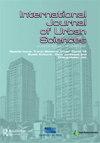Is travel behaviour an equity issue? Using GPS location data to assess the effects of income and supermarket availability on travel reduction during the COVID-19 pandemic
IF 3
3区 工程技术
Q2 ENVIRONMENTAL STUDIES
引用次数: 7
Abstract
ABSTRACT With recent research identifying mobility restrictions for alleviating the spread of COVID-19, governments have implemented stay-at-home measures, which in turn produced significant changes in people's travel behaviours. Despite these orders, however, people still have to make trips for work or to acquire essential goods. To better understand how these necessary trips influenced changes in individual mobility due to the pandemic, this study focused on the relationship between trip frequency and distance to median incomes, as well as between trip frequency and distance to supermarket density. We made use of the University of Maryland COVID-19 Impact Analysis Platform as our primary source for GPS travel data to study mobility changes at the county-level across the U.S.A. Results showed that trip frequency and distance were significantly different before the outbreak of COVID-19 and during three peak periods of COVID-19 infection. Specifically, we found the reduction of both frequency and distance of trips is negatively correlated to both median income and supermarket density. Thus we conclude that individual choice in adherence to staying-at-home is less dependent on the lockdown measures and more influenced by financial capacity and access to necessary goods and services. These findings could help inform policy development and programmatic responses to help people reduce their mobility. For example, government authorities might consider monthly stimulus or other financial support programs that would allow people greater access to delivery services. In the future, urban planners and policymakers should address the root causes that lead to such economic disparities and food insecurities, in order to build resilience in the face of possible future pandemics.旅行行为是一个公平问题吗?利用GPS定位数据评估COVID-19大流行期间收入和超市可用性对减少旅行的影响
最近的研究发现,限制流动可以缓解COVID-19的传播,各国政府纷纷实施居家措施,这反过来又使人们的旅行行为发生了重大变化。然而,尽管有这些命令,人们仍然不得不出差或购买必需品。为了更好地理解这些必要的旅行是如何影响疫情导致的个人流动性变化的,本研究重点研究了旅行频率与到收入中位数的距离之间的关系,以及旅行频率与到超市密度的距离之间的关系。我们利用马里兰大学新冠肺炎影响分析平台作为主要数据来源,对美国各县的出行数据变化进行了研究。结果表明,在新冠肺炎疫情爆发前和三个感染高峰期,出行频率和距离存在显著差异。具体来说,我们发现出行频率和距离的减少与收入中位数和超市密度呈负相关。因此,我们得出的结论是,个人选择是否留在家中不受封锁措施的影响较小,而更多地受到经济能力和获得必要商品和服务的影响。这些发现有助于为政策制定和方案应对提供信息,以帮助人们减少流动性。例如,政府当局可以考虑每月刺激计划或其他财政支持计划,使人们能够更多地获得送货服务。未来,城市规划者和决策者应解决导致这种经济差距和粮食不安全的根本原因,以便在未来可能出现的大流行病面前建立复原力。
本文章由计算机程序翻译,如有差异,请以英文原文为准。
求助全文
约1分钟内获得全文
求助全文

 求助内容:
求助内容: 应助结果提醒方式:
应助结果提醒方式:


